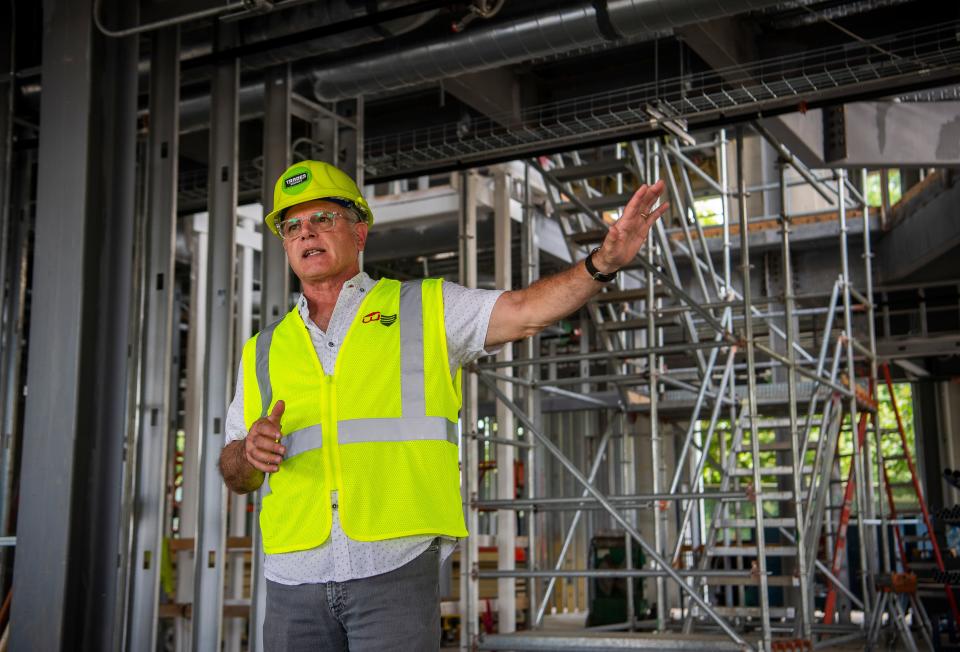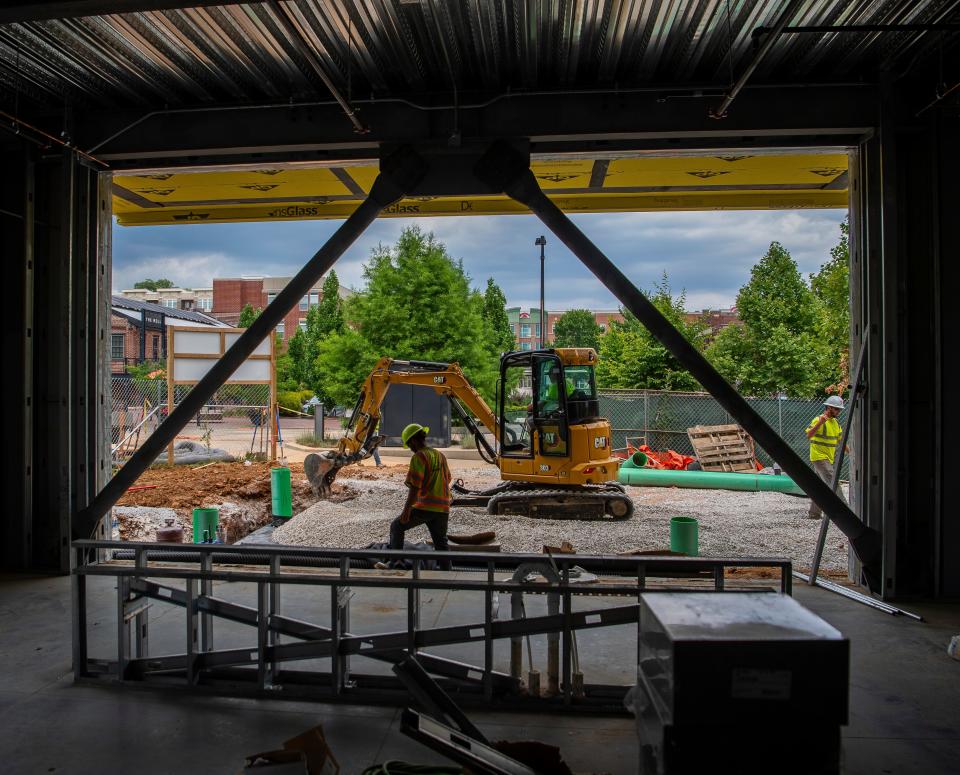This Indiana city is building a $13M tech center to diversify its economy. Will it work?
A 22,000-square-foot, three-story tech center, called The Forge, is starting to take shape next to Bloomington’s business incubator, The Dimension Mill. Construction workers on a recent Tuesday afternoon carried building materials and operated machinery. They are expected to soon install drywall, which lay in packages on the building’s floor. Late this year, the office could welcome its first tenants.
Local officials have placed high hopes in the structure: It is to help establish an innovation hub, offer space for growth-stage companies, provide recent IU grads with employment opportunities and tech companies with access to an educated workforce and customers including the U.S. military at Crane.
“It’s going to be a great building. I can’t wait for it to be finished,” said John Fernandez, Bloomington’s former mayor who now oversees the project as part of his role with the Mill, as senior vice president of innovation and strategic partnerships.

Jennifer Pearl, president of the Bloomington Economic Development Corp., said The Forge will help create a high-tech employment cluster that, much like the local life sciences cluster, will “diversify the local economy.”
Carol Rogers, director of the Indiana Business Research Center, said she believes the city’s effort can succeed, in part because of broad support from state and federal governments — which helped fund the building — Indiana University, Ivy Tech, Crane, and the potential for faculty and students to become part of an “innovation supply chain.”
However, Rogers warned, the local efforts may be undermined by Bloomington’s distance to an international airport, potentially insufficient investment in quality of life, and tough competition — from Indianapolis, West Lafayette, Detroit and Chicago.
The Bloomington structure’s cost has ballooned to nearly $13 million — more than double the initial estimate — in part because of post-pandemic inflation. And Peter Dorfman, a local journalist and blogger who has worked for tech companies on both coasts, said he believes the Bloomington area lacks the number of engineers companies need when they move from startup to growth phase.
Canceled: $150M investment in semiconductors in southern Indiana falls through
“I remain skeptical that Bloomington has anything unique and differentiating to offer tech companies, other than a low-wage workforce,” he said via email.
And, he said, the city is building a speculative office building at a time when the commercial real estate sector is dealing with some enormous post-pandemic headaches.
"In the absence of firm commitments from new paying tenants, I see reasons to temper expectations,” Dorfman said.
City: Bloomington's tech center to help create 'innovation hub'
Fernandez counters the project isn’t primarily about real estate.
“It’s about bringing together a lot of tech-based and tech-adjacent companies to build the (trades) district into a true … innovation hub,” he said last week as he stood between the Mill and the Forge, where he envisions planned and chance encounters between young entrepreneurs and tech workers.
Fernandez said the economic sectors the city is pursuing — cyber security, defense technology, artificial intelligence/machine learning and creative arts — already are growing in Bloomington, but they remain scattered throughout the city.
According to the city’s trades district website, about 500 people already work in Monroe County in each artificial intelligence and cyber security. An additional 1,700 work in defense tech.
With the Forge, the Mill and other developments, the city is trying to build a hub, or community, that gives likeminded people a neighborhood, a place where IU graduates can feel comfortable and see career opportunities, Fernandez said.
Studies have shown, he said, that having tech companies in clusters, such as research parks, gives them a greater chance for survival. And attracting and retaining tech companies also should help Bloomington boost wages, which lag the state and national averages.
The Forge will have conference rooms and smaller “huddle” booths that provide privacy for one-on-one meetings or a Zoom call. Each tenant additionally will have its own office space on one of two levels. A third level will provide room for storage and mechanical equipment, along with access to a small deck where tenants can meet clients outside — or relax with a drink after work.

Fernandez said the city is marketing the property now and has an “active pipeline” of “a little over half a dozen prospects,” including one or two companies that could graduate from the Mill into the Forge.
The structure's $13 million price tag will be paid with about $9 million in local funds, including $6 million in tax increment financing dollars and $3 million in Community Redevelopment Economic District dollars. The bulk of the rest comes from the federal government.
Pearl, whose organization helped the city obtain a $3.5 million federal grant for the Forge, said the local economy went from limestone to furniture making to life sciences, and the tech sector represents the next expansion.
Investments in microelectronics across the state, in defense contractors at Westgate@Crane, in education at Ivy Tech and IU mean people are relocating here from other parts of the country, and some of them will need the world-class office space the Forge aims to provide, Pearl said.
Rogers, of the IBRC, said via email all the private and public investments may coalesce to create a “magnetic effect: It is more than ‘if we build it, they will come.’ The Mill has already brought in new businesses, and the Forge provide a visible, physical space for both innovation and growth.”

And, she said, “IU and Ivy Tech can provide a crucial pipeline for workforce, spanning from middle to high skills, and capitalize on budding entrepreneurs that can help feed the bigger businesses with innovation.”
Looking for a new, lucrative career? Ivy Tech Bloomington may have the answer
Rogers also said the region’s advantages include relatively low cost of living — despite expensive housing — room to grow, easy access to the north and south and a welcoming vibe.
However, she said, if the effort is to succeed, it will require collaboration and buy-in throughout the community and region.
And it may fail if the community does not invest enough in quality of life, infrastructure, transportation and education.
Also, Rogers said, “competition for talent is brutal.”
Dorfman said the community especially lacks the kind of talent businesses need after the start-up phase: engineers.
“IU has the Luddy School, a great source of young software developers, but there’s no engineering school here. That’s an entirely different discipline. And there aren’t a lot of seasoned engineers in the talent pool,” he said.
“So the startups pick up and move to Indianapolis for the commercialization phase. That’s what happened with The Bee Corporation, a small analytics company started by an IU grad, and with Mandolin, a music streaming platform started across the street from the Buskirk Chumley but which quickly moved to Indy to scale up.
“Bloomington doesn’t have a lot to show for its efforts to create business opportunities. It’s not what we do,” Dorfman said. “What we do is put up buildings. That’s only one step in the process, and it’s usually not even the first step.”
Fernandez said he remains optimistic that the Forge will succeed and the city will hit its targets of 50% occupancy in 2025 and 75% in 2026.
“I think we’ll be higher than that,” he said.
Boris Ladwig can be reached at bladwig@heraldt.com.
This article originally appeared on The Herald-Times: Bloomington Indiana $13M tech incubator to open late 2024

